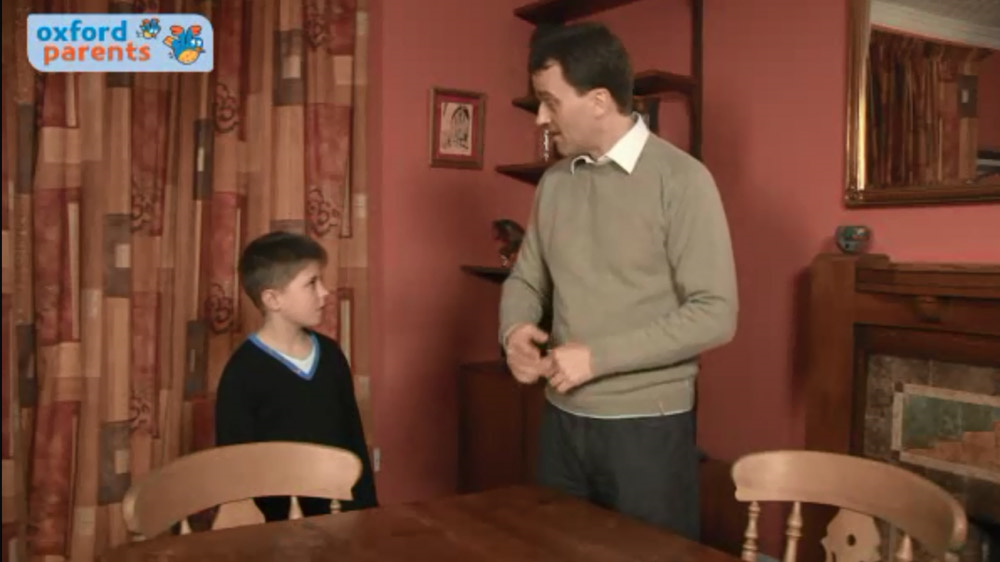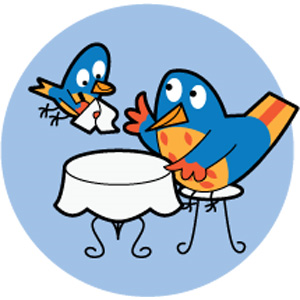کودکان عاشق بازی هستند! هنگامی که سرگرم باشند فراموش میکنند که در حال تمرین انگلیسی هستند و فقط خوشحالند که مشغول بازی کردن هستند. بیشتر بازیهایی که در اینجا آمده است خیلی ساده هستند حتی اگر شما خیلی هم انگلیسی بلد نباشید. (برای تماشای ویدیو کلیک کنید)
بازیهای نمایشی مثل بازی کافه، به کودک شما کمک میکند تا زبانی که در موقعیتهای واقعی استفاده میشود را به کار ببرد. بازیهایی که واژگان را تمرین میکنند خیلی به کودک شما کمک میکند تا لغات جدید را به یاد بیاورد یا لغات را دوره کند.
حتما صفحه آموزش زبان انگلیسی ما را اینجا مطالعه کنید.

مترجم: رؤیا کریمی جنابی
بازی کافه را انجام دهید

این متن (helpful language (PDF, 200KB، برگرفته از ویدیو است و شما میتوانید از آن برای انجام تمرینات همراه با فرزندتان، کمک بگیرید. میتوانید در واقعیت این کار را بکنید یا این که از اسباببازی استفاده کنید و واژگان مربوطه را تمرین کنید، مثل: What’s this? Find a bviscuit.
اگر میخواهید فرزند شما نوشتن لغات را تمرین کند یک منوی ساده درست کنید. در کشورهایی که به آموزش زبان انگلیسی میپردازند و با فرزندان خود انگلیسی صحبت میکنند مردم خیلی از کلمات please و thank you استفاده میکنند. به ترتیب نقش گارسن و مشتری را بازی کنید. زبان مناسب برای این موقعیت:
What would you like?
Can I have a sandwich, please?
Can I have some more coffee, please?
How much is a coffee?
Here you are?
Thank you.
No, sorry. We haven’t got any sandwiches.
This cake is delicious.
I don’t like pizza!
Do you like biscuits?
میتوانید بازی خرید را هم با لباس یا اسباببازی انجام دهید.
یک شوی لباس سرگرم کننده راه بیندازید
چند دست لباس خندهدار بردارید و یک شوی سرگرم کننده راه بیندازید. فرزندانتان باید لباسها را بپوشند و همدیگر را معرفی کنند. آنها باید بگویند که چه پوشیدهاند و چیزی درباره لباسها بگویند.
This is Sophie. Today she’s wearing red shorts and a very big T- shirt. Perfect for a sunny day.
This is Martin. Today he’s wearing a jumper and a pair of green trousers. Perfect for a cold day.
با کارتهای جفتی بازی کنید
از کارتهایی استفاده کنید که دو تصویر در آنها تکرار شده است و یا روی آنها کلماتی نوشته شده که با تصاویر مطابقت دارند. کارتها را پشت و رو میگذارید. هر کس به نوبت دو کارت بر میدارد و به نفر دیگر میگوید که روی کارت چیست. اگر یکی از بازیکنها دو کارت با تصویر مشابه یا کلمه مرتبط بردارد، آن کارتها را از آن خود میکند. تا وقتی که کارتها تمام شود بازی ادامه مییابد. برنده کسی است که کارتهای بیشتری برده است. میتوانید از بخش (these pictures(PDF,3MB پرینت بگیرید.
کلمات را به ترتیب قرار دهید
یک سری کارت تصویری داشته باشید. کارتهای خودتان را بر بزنید (Shuffle) و به ترتیب برای فرد دیگر بلند بخوانید. فرد دیگر گوش میکند و کارتهای خودش را به همان ترتیب کارتهای شما میچیند. بعد آنها را مقایسه میکنید که ببینید درست چیده شده یا نه.
کلمات را گروهبندی کنید
کارتهای زیادی با کلماتی که کودکتان به انگلیسی بلد است، تهیه کنید. کلمات باید از گروههای واژگانی متفاوت باشند. به کودک خود بگویید که کلمات را در دو یا سه گروه قرار دهد. میتواند به هر صورت که بخواهد آنها را دستهبندی کند. از او بخواهید فهرستی از کلمات درست کند و بگوید که هر گروه چه نام دارد، میتواند از زبان مخصوص خود برای توضیح دادن استفاده کند. مثلاً:
Snow, Monday, zebra, crocodile, rain, Tuesday, monkey
Animals: zebra, crocodile, monkey
Weather: snow, rain
Days: Monday, Tuesday
کلمات ناجور را پیدا کنید
چهار کلمه انتخاب کنید که سه تای آنها در یک گروه قرار میگیرند و یکی از آنها نه مثل
Dog, cat, table, rabbit.
از کودک خود بخواهید که کلمهای که با بقیه جور نیست را نام ببرد (table). سپس کلمات ناجور را سختتر کنید مثلاً حیوانات چهارپا و یک حیوان دوپا، اعداد فرد و یک عدد زوج، کلماتی که با " b " شروع میشوند و یک کلمه که با " c " شروع میشود.
تصویر یک هیولا بکشید
به نوبت یک هیولا را توصیف کنید. هر کدام باید یواشکی یک هیولا بکشد و بعد از اتمام کار، نقاشیها را با هم مقایسه کنید مثلاً:
My monster has a big head and long hair. He has three green eyes and a small blue nose. He has a very big mouth with two teeth. He has a small pink body. He has six green arms and one red leg.
بازی Kim’s Game را انجام دهید
از حیوانات اسباببازی استفاده کنید. هشت تا حیوان مختلف و یا بیشتر (هر چه بیشتر باشد سختتر است) را روی یک سینی بگذارید و ببینید آیا فرزندتان نام آنها را بلد است. بگذارید ده ثانیه به آنها نگاه کند و بعد چشمهای خود را ببندد. یکی از حیوانها را بردارید. به کودکتان بگوید نگاه کند و بگوید کدام حیوان نیست. میتوانید از گروه کلمات دیگری که در درس کودکتان به آن اشاره شده هم استفاده کنید مثل: food, clothes, toys
مقاله های مشابه
شما همچنین می توانید این مقاله ها را مطالعه کنید:
استفاده از گرامر برای مکالمه
انگلیسی حرف زدن در خانه
خواندن به همراه کودکتان
شعرها و بازیهای حرکتی
کاردستیها
Games and role play (ages 6-1)
Children love games! When they have fun, children forget that they are practising English and are just happy to play. Most of the games here are very easy even if you don't speak much English.
Role-play games, like the café game, will help your child to use language in a real situation. Games that practise vocabulary are great to help your child remember new words or to review words.
Café
This is a sheet of helpful language (PDF, 200KB) from the video. Use it to help you do the activities with your child.
Play cafés. You can make a café with real or toy food and practise the vocabulary when you set it up, e.g. What's this? Find a biscuit. If you want your child to practise writing words, make a simple menu. In English-speaking countries, people use please and thank you a lot.
Take it in turns to be the waiter and the customer.
Useful language:
What would you like?
Can I have a sandwich, please?
Can I have some more coffee, please?
How much is a coffee?
Here you are.
Thank you.
No, sorry. We haven't got any sandwiches.
This cake is delicious.
I don't like pizza!
Do you like biscuits?
You can play shopping games like this with clothes or toys.
Funny fashion show
Get out some fun dressing-up clothes and have a funny fashion show. Your children can dress up and introduce each other. They can say what they are wearing and say something about the clothes.
This is Sophie. Today she's wearing red shorts and a very big T-shirt. Perfect for a sunny day.
This is Martin. Today he's wearing a jumper and a pair of green trousers. Perfect for a cold day.
Pairs
Use cards with two of every picture or with words and matching pictures.
Put the cards face down on the table.
Take it in turns to turn over two cards and say what is on them.
When a player turns over two pictures that are the same, or a word that goes with a picture, they keep the cards.
Play until the cards have all gone. The winner is the one with the most cards at the end. You can print these pictures (PDF, 3MB).
Order the words
Have a set of picture cards each. Shuffle your cards and read them out in order. The other person listens and puts their cards in the same order. Then compare your cards to see if they match.
Group the words
Make word cards with lots of different words that your child knows in English. The words must be from a few different vocabulary sets. Tell your child to put the words into two or three groups. They can group them in any way they like. Ask your child to list the things in each group and explain what this group is called – they may need to use their own language to explain. For example:
snow, Monday, zebra, crocodile, rain, Tuesday, monkey
Animals: zebra, crocodile, monkey
Weather: snow, rain
Days: Monday, Tuesday
Odd one out
Say four words where three are part of the group but one is not, e.g. dog, cat, table, rabbit. Ask your child to say which word is the odd one out (table). Make the odd one out more difficult, e.g. four-legged animals and a two-legged animal; odd numbers and an even number; words that start with 'b' and a word that starts with 'c'.
Draw monsters
Take it in turns to describe a monster. Both of you draw the monster in secret. When you have finished, compare pictures. For example:
My monster has a big head and long hair. He has three green eyes and a small blue nose. He has a very big mouth with two teeth. He has a small pink body. He has six green arms and one red leg.
Kim's game
Use toy animals. Put eight or more (more is harder) different animals on a tray and check your child knows the words. Let your child look for 10 seconds then tell them to close their eyes. Take away one animal. Tell your child to look and say which animal has gone. You can use other vocabulary groups from your child's course book, e.g. food, clothes, toys.